UNIT 2 THE REPUBLIC OF TATARSTAN KAZAN. PLACES

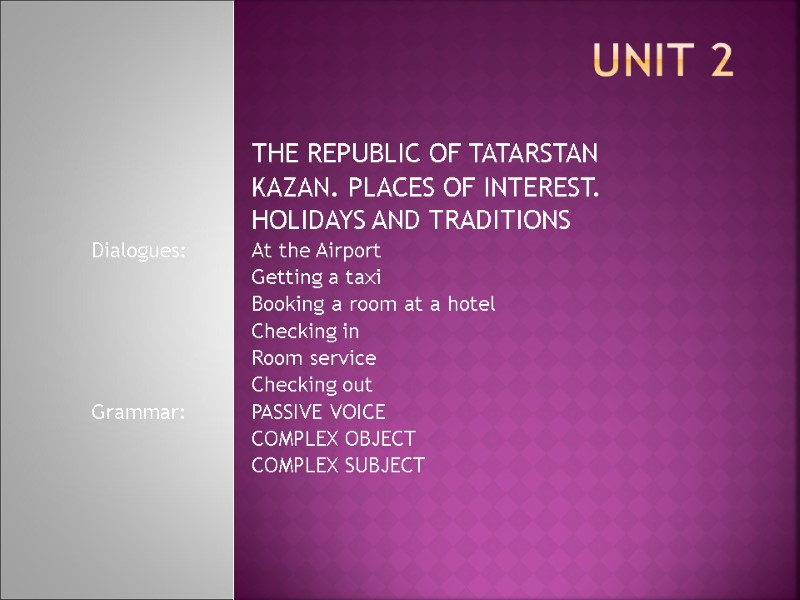
UNIT 2 THE REPUBLIC OF TATARSTAN KAZAN. PLACES OF INTEREST. HOLIDAYS AND TRADITIONS Dialogues: At the Airport Getting a taxi Booking a room at a hotel Checking in Room service Checking out Grammar: PASSIVE VOICE COMPLEX OBJECT COMPLEX SUBJECT
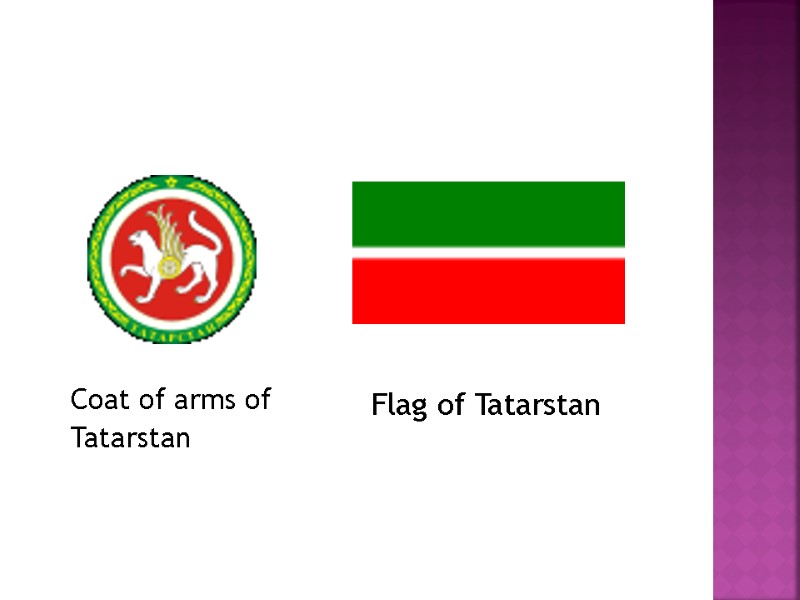
Coat of arms of Tatarstan Flag of Tatarstan
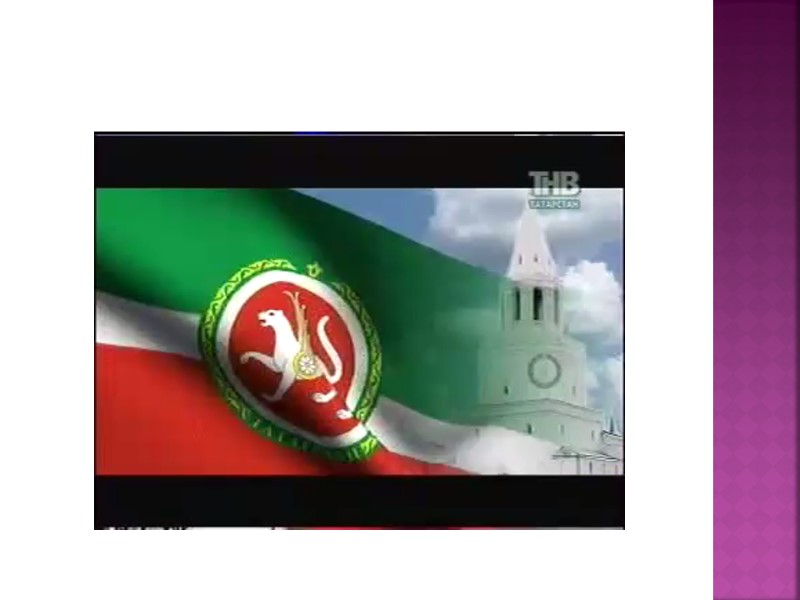
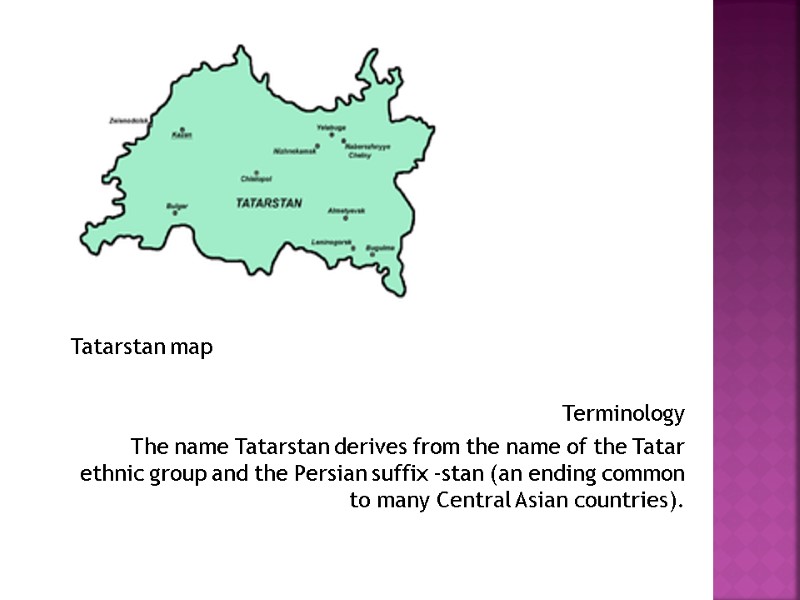
Tatarstan map Terminology The name Tatarstan derives from the name of the Tatar ethnic group and the Persian suffix -stan (an ending common to many Central Asian countries).

Middle Ages The Little Minaret of Bolghar has been preserved since the Middle Ages The earliest known organized state within the boundaries of Tatarstan was Volga Bulgaria (c. 700–1238 CE). The Volga Bulgars had an advanced mercantile state with trade contacts throughout Inner Eurasia, the Middle East and the Baltic, which maintained its independence despite pressure by such nations as the Khazars, the Kievan Rus and the Kipchaks. Islam was introduced by missionaries from Baghdad around the time of ibn Fadlan's journey in 922.
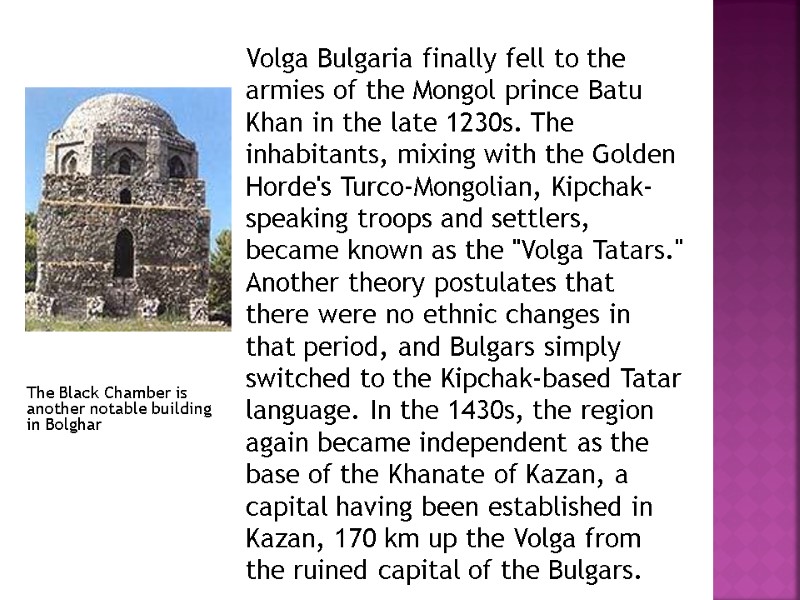
The Black Chamber is another notable building in Bolghar Volga Bulgaria finally fell to the armies of the Mongol prince Batu Khan in the late 1230s. The inhabitants, mixing with the Golden Horde's Turco-Mongolian, Kipchak-speaking troops and settlers, became known as the "Volga Tatars." Another theory postulates that there were no ethnic changes in that period, and Bulgars simply switched to the Kipchak-based Tatar language. In the 1430s, the region again became independent as the base of the Khanate of Kazan, a capital having been established in Kazan, 170 km up the Volga from the ruined capital of the Bulgars.
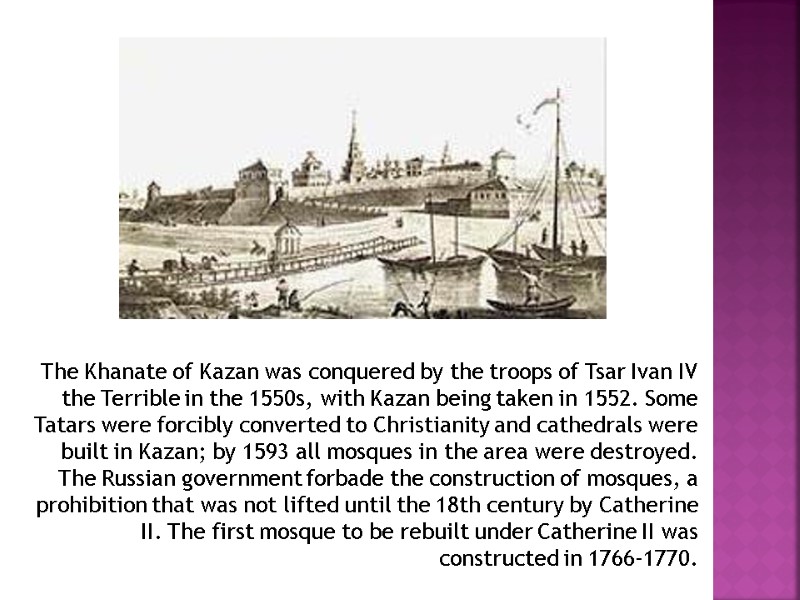
The Khanate of Kazan was conquered by the troops of Tsar Ivan IV the Terrible in the 1550s, with Kazan being taken in 1552. Some Tatars were forcibly converted to Christianity and cathedrals were built in Kazan; by 1593 all mosques in the area were destroyed. The Russian government forbade the construction of mosques, a prohibition that was not lifted until the 18th century by Catherine II. The first mosque to be rebuilt under Catherine II was constructed in 1766-1770.
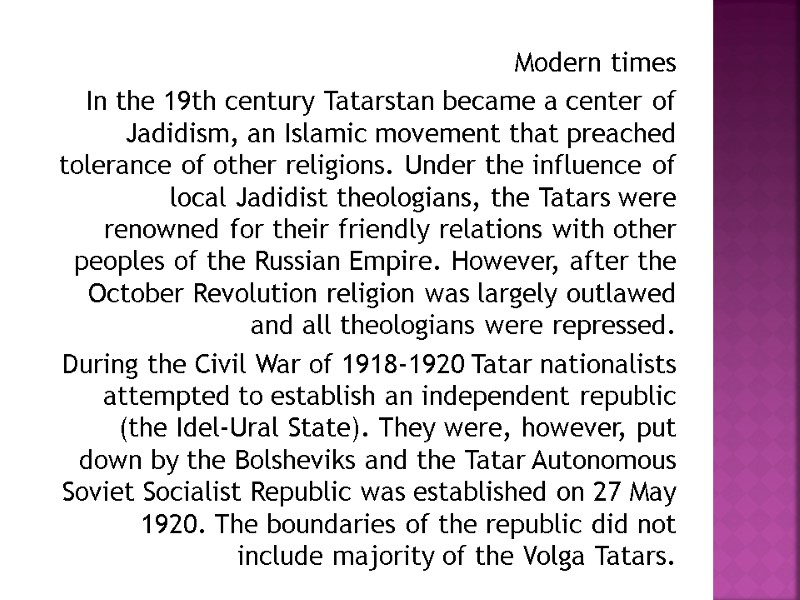
Modern times In the 19th century Tatarstan became a center of Jadidism, an Islamic movement that preached tolerance of other religions. Under the influence of local Jadidist theologians, the Tatars were renowned for their friendly relations with other peoples of the Russian Empire. However, after the October Revolution religion was largely outlawed and all theologians were repressed. During the Civil War of 1918-1920 Tatar nationalists attempted to establish an independent republic (the Idel-Ural State). They were, however, put down by the Bolsheviks and the Tatar Autonomous Soviet Socialist Republic was established on 27 May 1920. The boundaries of the republic did not include majority of the Volga Tatars.
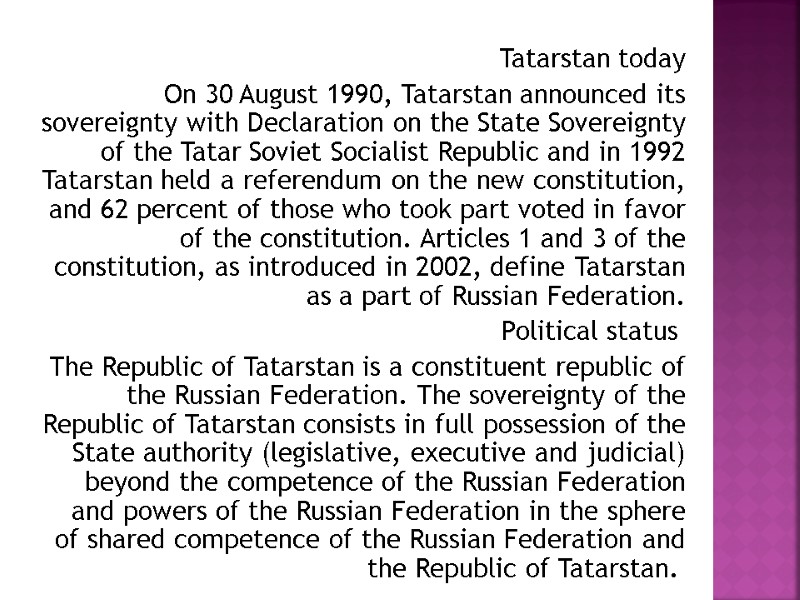
Tatarstan today On 30 August 1990, Tatarstan announced its sovereignty with Declaration on the State Sovereignty of the Tatar Soviet Socialist Republic and in 1992 Tatarstan held a referendum on the new constitution, and 62 percent of those who took part voted in favor of the constitution. Articles 1 and 3 of the constitution, as introduced in 2002, define Tatarstan as a part of Russian Federation. Political status The Republic of Tatarstan is a constituent republic of the Russian Federation. The sovereignty of the Republic of Tatarstan consists in full possession of the State authority (legislative, executive and judicial) beyond the competence of the Russian Federation and powers of the Russian Federation in the sphere of shared competence of the Russian Federation and the Republic of Tatarstan.
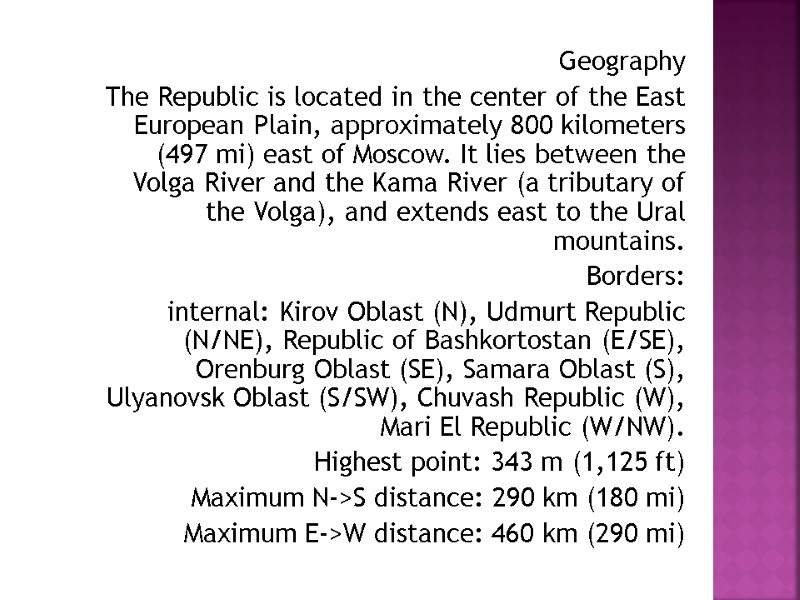
Geography The Republic is located in the center of the East European Plain, approximately 800 kilometers (497 mi) east of Moscow. It lies between the Volga River and the Kama River (a tributary of the Volga), and extends east to the Ural mountains. Borders: internal: Kirov Oblast (N), Udmurt Republic (N/NE), Republic of Bashkortostan (E/SE), Orenburg Oblast (SE), Samara Oblast (S), Ulyanovsk Oblast (S/SW), Chuvash Republic (W), Mari El Republic (W/NW). Highest point: 343 m (1,125 ft) Maximum N->S distance: 290 km (180 mi) Maximum E->W distance: 460 km (290 mi)
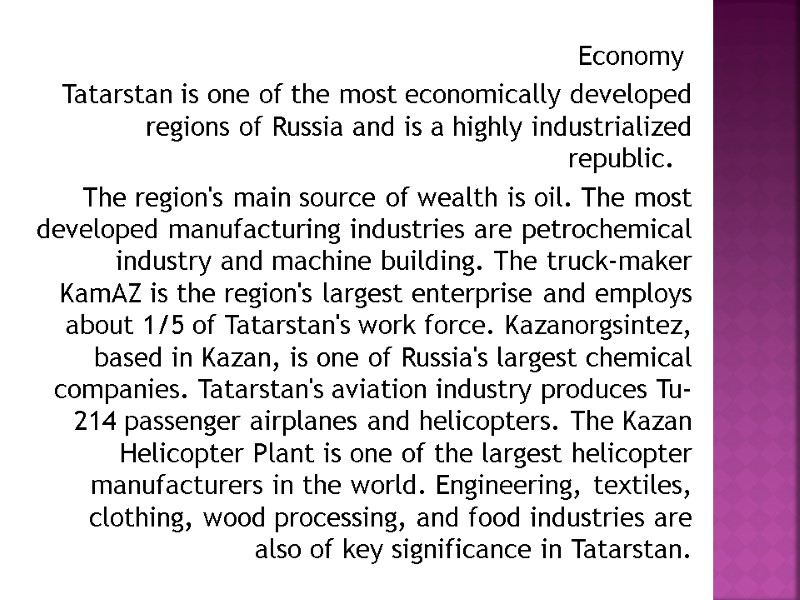
Economy Tatarstan is one of the most economically developed regions of Russia and is a highly industrialized republic. The region's main source of wealth is oil. The most developed manufacturing industries are petrochemical industry and machine building. The truck-maker KamAZ is the region's largest enterprise and employs about 1/5 of Tatarstan's work force. Kazanorgsintez, based in Kazan, is one of Russia's largest chemical companies. Tatarstan's aviation industry produces Tu-214 passenger airplanes and helicopters. The Kazan Helicopter Plant is one of the largest helicopter manufacturers in the world. Engineering, textiles, clothing, wood processing, and food industries are also of key significance in Tatarstan.
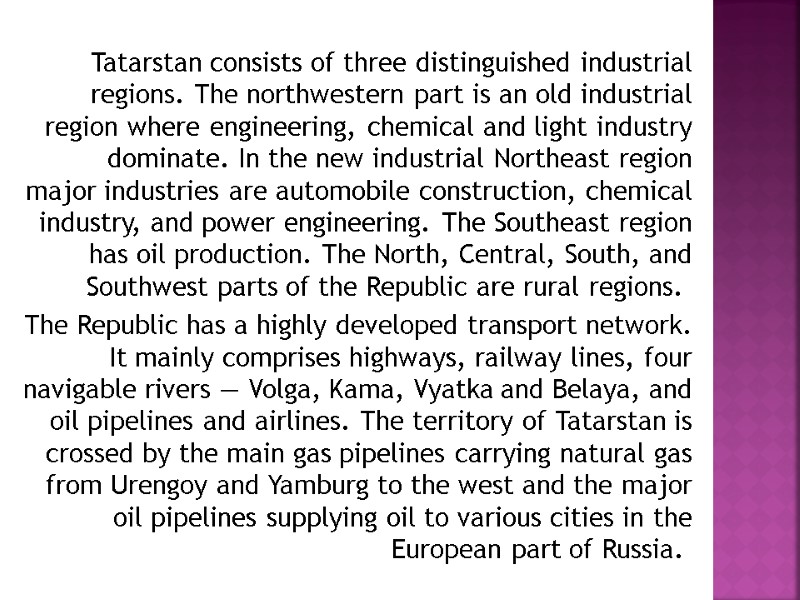
Tatarstan consists of three distinguished industrial regions. The northwestern part is an old industrial region where engineering, chemical and light industry dominate. In the new industrial Northeast region major industries are automobile construction, chemical industry, and power engineering. The Southeast region has oil production. The North, Central, South, and Southwest parts of the Republic are rural regions. The Republic has a highly developed transport network. It mainly comprises highways, railway lines, four navigable rivers — Volga, Kama, Vyatka and Belaya, and oil pipelines and airlines. The territory of Tatarstan is crossed by the main gas pipelines carrying natural gas from Urengoy and Yamburg to the west and the major oil pipelines supplying oil to various cities in the European part of Russia.
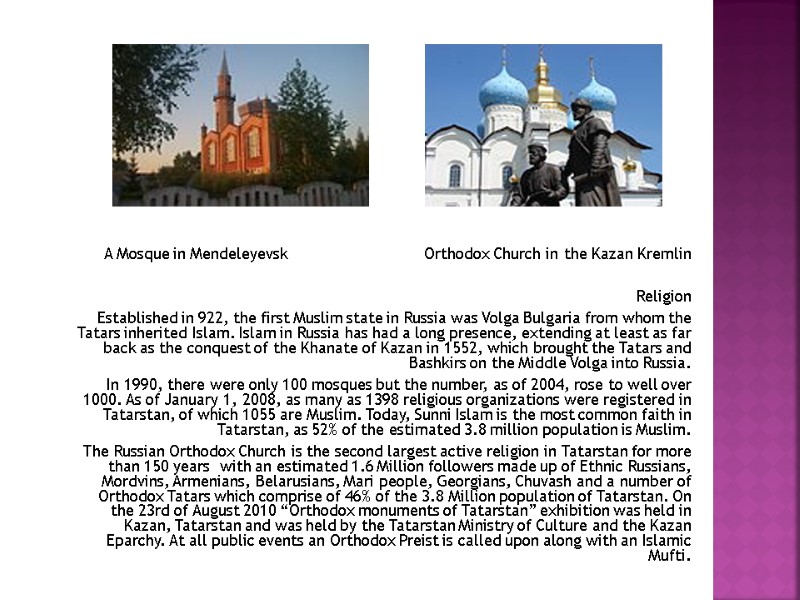
A Mosque in Mendeleyevsk Orthodox Church in the Kazan Kremlin Religion Established in 922, the first Muslim state in Russia was Volga Bulgaria from whom the Tatars inherited Islam. Islam in Russia has had a long presence, extending at least as far back as the conquest of the Khanate of Kazan in 1552, which brought the Tatars and Bashkirs on the Middle Volga into Russia. In 1990, there were only 100 mosques but the number, as of 2004, rose to well over 1000. As of January 1, 2008, as many as 1398 religious organizations were registered in Tatarstan, of which 1055 are Muslim. Today, Sunni Islam is the most common faith in Tatarstan, as 52% of the estimated 3.8 million population is Muslim. The Russian Orthodox Church is the second largest active religion in Tatarstan for more than 150 years with an estimated 1.6 Million followers made up of Ethnic Russians, Mordvins, Armenians, Belarusians, Mari people, Georgians, Chuvash and a number of Orthodox Tatars which comprise of 46% of the 3.8 Million population of Tatarstan. On the 23rd of August 2010 “Orthodox monuments of Tatarstan” exhibition was held in Kazan, Tatarstan and was held by the Tatarstan Ministry of Culture and the Kazan Eparchy. At all public events an Orthodox Preist is called upon along with an Islamic Mufti.
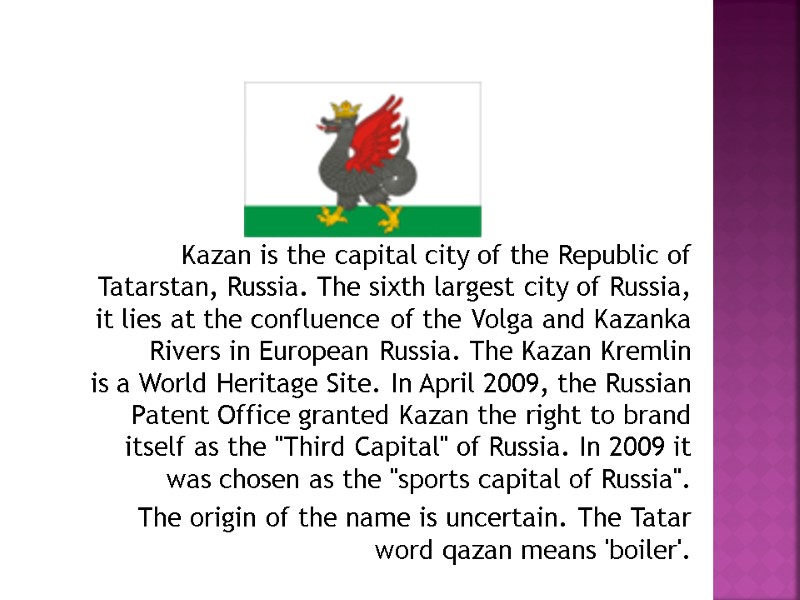
Kazan is the capital city of the Republic of Tatarstan, Russia. The sixth largest city of Russia, it lies at the confluence of the Volga and Kazanka Rivers in European Russia. The Kazan Kremlin is a World Heritage Site. In April 2009, the Russian Patent Office granted Kazan the right to brand itself as the "Third Capital" of Russia. In 2009 it was chosen as the "sports capital of Russia". The origin of the name is uncertain. The Tatar word qazan means 'boiler'.
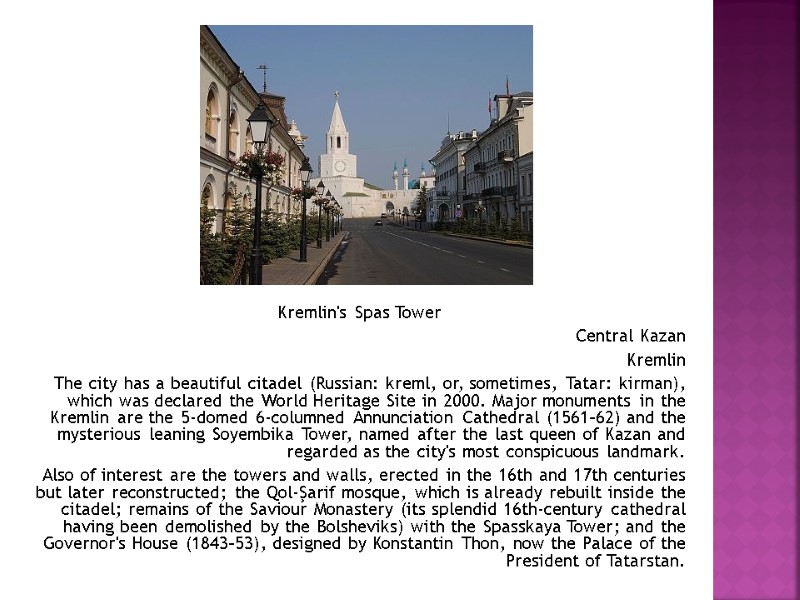
Kremlin's Spas Tower Central Kazan Kremlin The city has a beautiful citadel (Russian: kreml, or, sometimes, Tatar: kirman), which was declared the World Heritage Site in 2000. Major monuments in the Kremlin are the 5-domed 6-columned Annunciation Cathedral (1561–62) and the mysterious leaning Soyembika Tower, named after the last queen of Kazan and regarded as the city's most conspicuous landmark. Also of interest are the towers and walls, erected in the 16th and 17th centuries but later reconstructed; the Qol-Şarif mosque, which is already rebuilt inside the citadel; remains of the Saviour Monastery (its splendid 16th-century cathedral having been demolished by the Bolsheviks) with the Spasskaya Tower; and the Governor's House (1843–53), designed by Konstantin Thon, now the Palace of the President of Tatarstan.
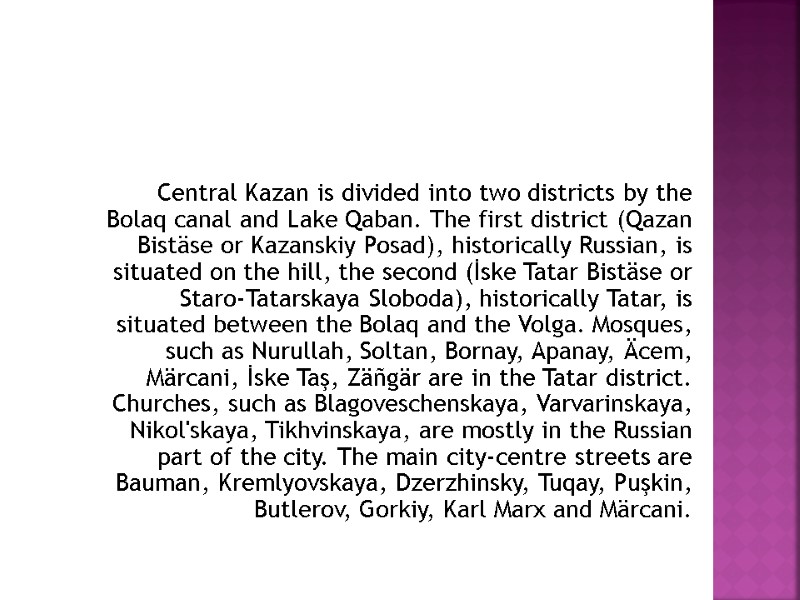
Central Kazan is divided into two districts by the Bolaq canal and Lake Qaban. The first district (Qazan Bistäse or Kazanskiy Posad), historically Russian, is situated on the hill, the second (İske Tatar Bistäse or Staro-Tatarskaya Sloboda), historically Tatar, is situated between the Bolaq and the Volga. Mosques, such as Nurullah, Soltan, Bornay, Apanay, Äcem, Märcani, İske Taş, Zäñgär are in the Tatar district. Churches, such as Blagoveschenskaya, Varvarinskaya, Nikol'skaya, Tikhvinskaya, are mostly in the Russian part of the city. The main city-centre streets are Bauman, Kremlyovskaya, Dzerzhinsky, Tuqay, Puşkin, Butlerov, Gorkiy, Karl Marx and Märcani.
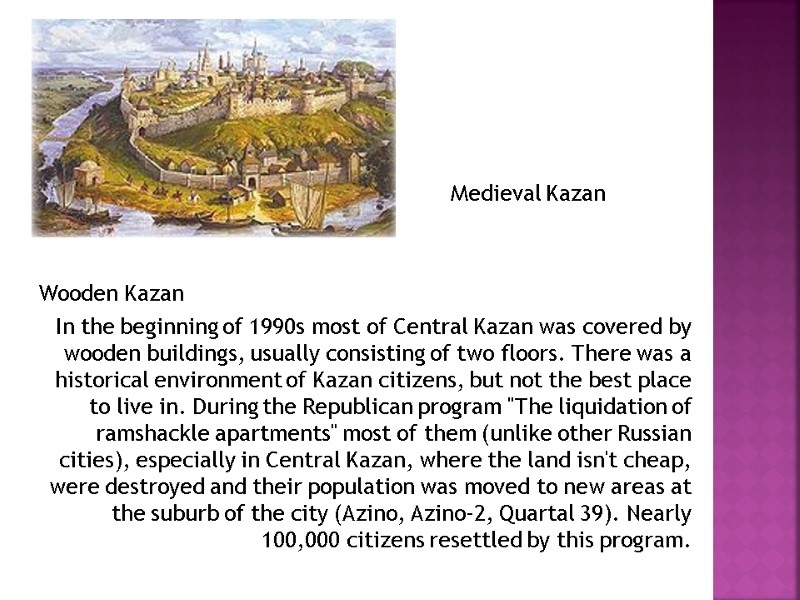
Medieval Kazan Wooden Kazan In the beginning of 1990s most of Central Kazan was covered by wooden buildings, usually consisting of two floors. There was a historical environment of Kazan citizens, but not the best place to live in. During the Republican program "The liquidation of ramshackle apartments" most of them (unlike other Russian cities), especially in Central Kazan, where the land isn't cheap, were destroyed and their population was moved to new areas at the suburb of the city (Azino, Azino-2, Quartal 39). Nearly 100,000 citizens resettled by this program.

Other major buildings Another significant building in central Kazan is the former "Smolentzev and Shmelev" tea house and hotel, now the Shalyapin Palace Hotel. It is located at 7/80 Universitetskaya Street, at the corner of Universitetskaya and Bauman. A major landmark of late-19th and early-20th century commercial architecture, it consists of two portions. The original portion, built for a merchant named Usmanov in the 1860s, was bought by the inter-related families of Efim Smolentzev and Pavel and Nikolai Shmelev in 1899. They operated a store selling, among other things, tea. In 1910, the Smolentevs and Shmelevs constructed another portion, designed by architect Vasili Trifonov, and operated a hotel there. After the Russian Revolution, the building eventually became the Hotel Soviet and after 2000 it was heavily renovated to reopen as the Shalyapin Palace Hotel.
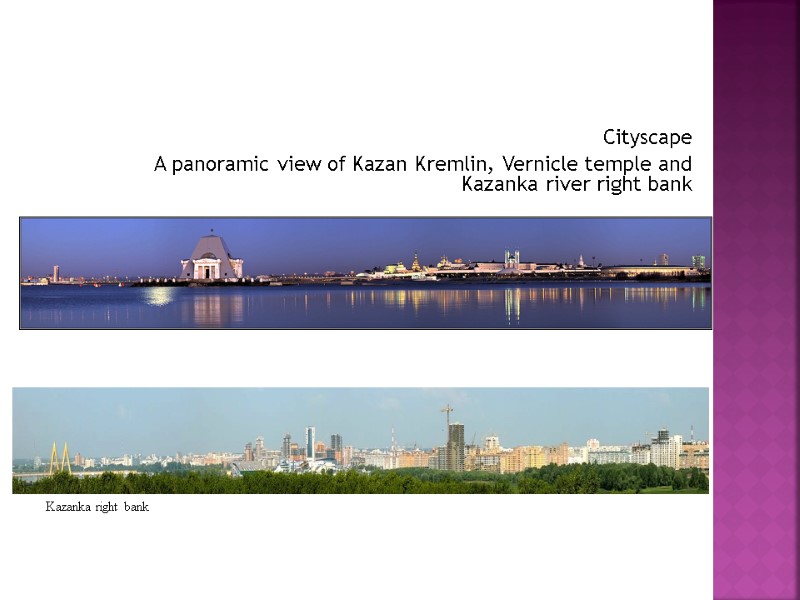
Cityscape A panoramic view of Kazan Kremlin, Vernicle temple and Kazanka river right bank Kazanka right bank
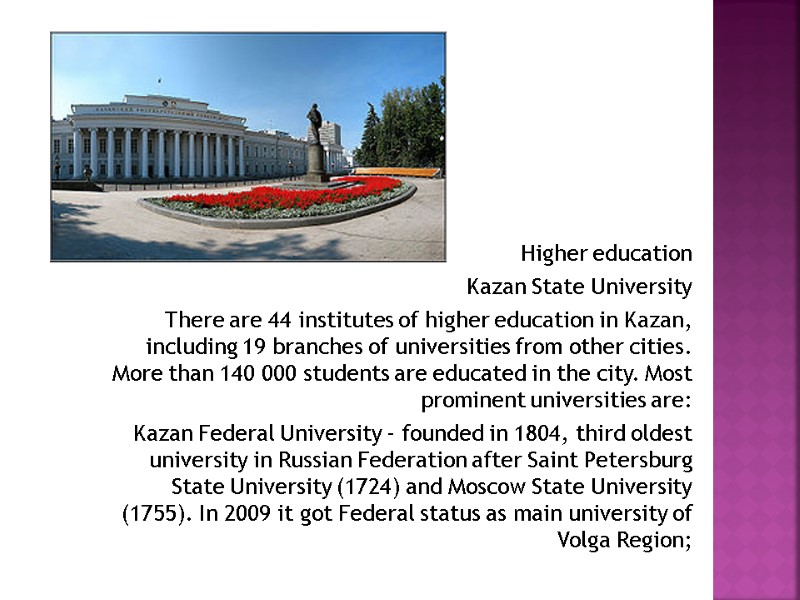
Higher education Kazan State University There are 44 institutes of higher education in Kazan, including 19 branches of universities from other cities. More than 140 000 students are educated in the city. Most prominent universities are: Kazan Federal University - founded in 1804, third oldest university in Russian Federation after Saint Petersburg State University (1724) and Moscow State University (1755). In 2009 it got Federal status as main university of Volga Region;
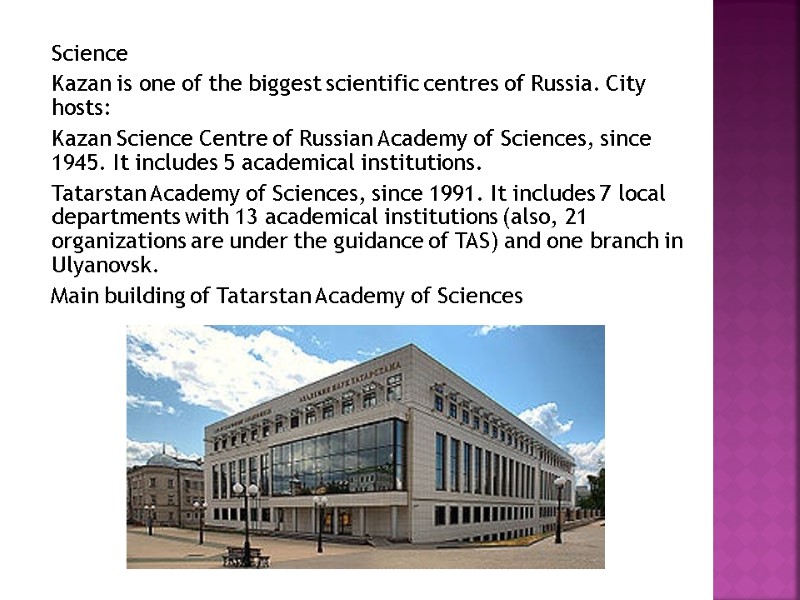
Science Kazan is one of the biggest scientific centres of Russia. City hosts: Kazan Science Centre of Russian Academy of Sciences, since 1945. It includes 5 academical institutions. Tatarstan Academy of Sciences, since 1991. It includes 7 local departments with 13 academical institutions (also, 21 organizations are under the guidance of TAS) and one branch in Ulyanovsk. Main building of Tatarstan Academy of Sciences
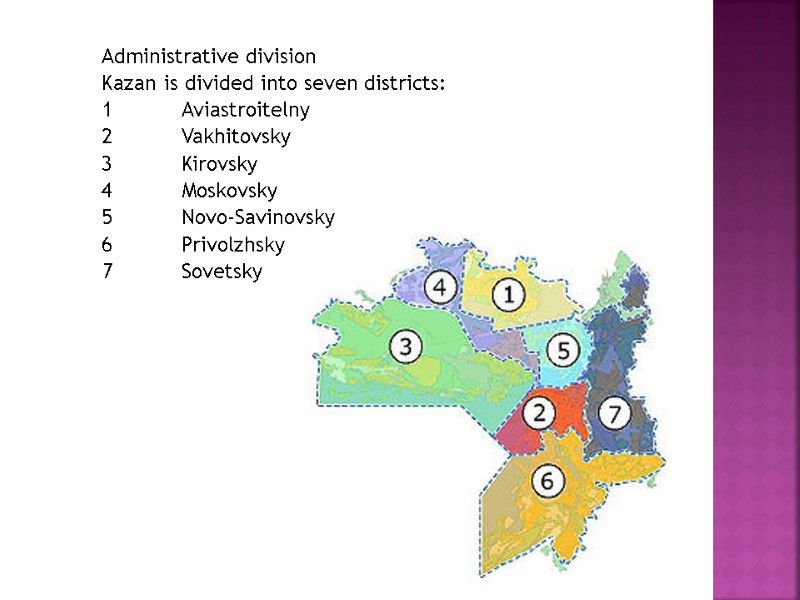
Administrative division Kazan is divided into seven districts: 1 Aviastroitelny 2 Vakhitovsky 3 Kirovsky 4 Moskovsky 5 Novo-Savinovsky 6 Privolzhsky 7 Sovetsky
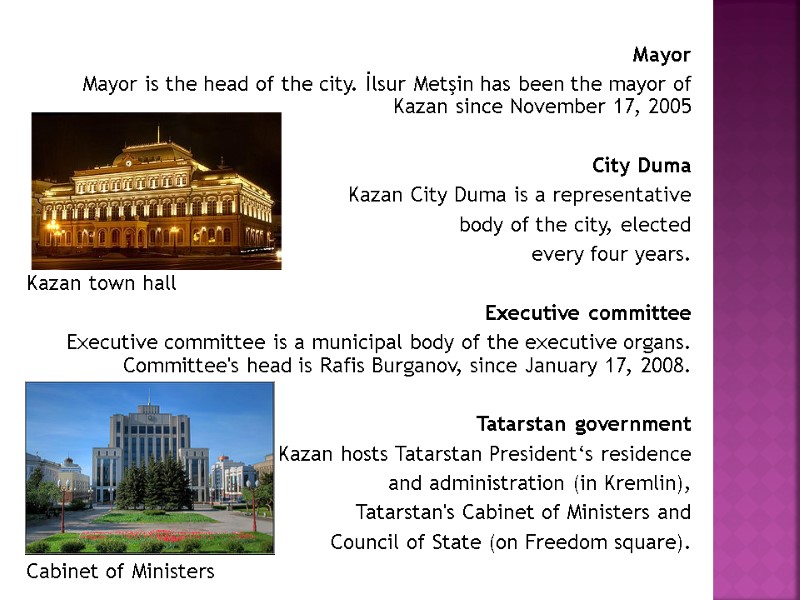
Mayor Mayor is the head of the city. İlsur Metşin has been the mayor of Kazan since November 17, 2005 City Duma Kazan City Duma is a representative body of the city, elected every four years. Kazan town hall Executive committee Executive committee is a municipal body of the executive organs. Committee's head is Rafis Burganov, since January 17, 2008. Tatarstan government Kazan hosts Tatarstan President‘s residence and administration (in Kremlin), Tatarstan's Cabinet of Ministers and Council of State (on Freedom square). Cabinet of Ministers
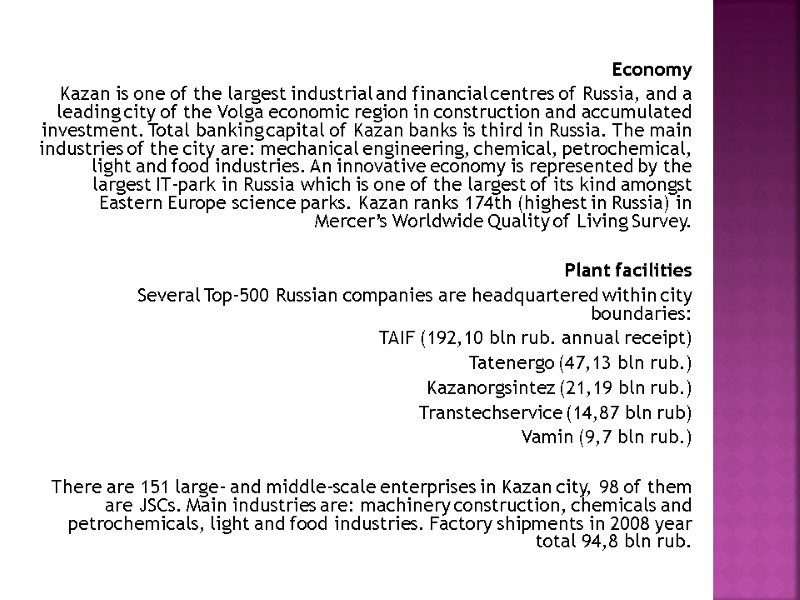
Economy Kazan is one of the largest industrial and financial centres of Russia, and a leading city of the Volga economic region in construction and accumulated investment. Total banking capital of Kazan banks is third in Russia. The main industries of the city are: mechanical engineering, chemical, petrochemical, light and food industries. An innovative economy is represented by the largest IT-park in Russia which is one of the largest of its kind amongst Eastern Europe science parks. Kazan ranks 174th (highest in Russia) in Mercer’s Worldwide Quality of Living Survey. Plant facilities Several Top-500 Russian companies are headquartered within city boundaries: TAIF (192,10 bln rub. annual receipt) Tatenergo (47,13 bln rub.) Kazanorgsintez (21,19 bln rub.) Transtechservice (14,87 bln rub) Vamin (9,7 bln rub.) There are 151 large- and middle-scale enterprises in Kazan city, 98 of them are JSCs. Main industries are: machinery construction, chemicals and petrochemicals, light and food industries. Factory shipments in 2008 year total 94,8 bln rub.
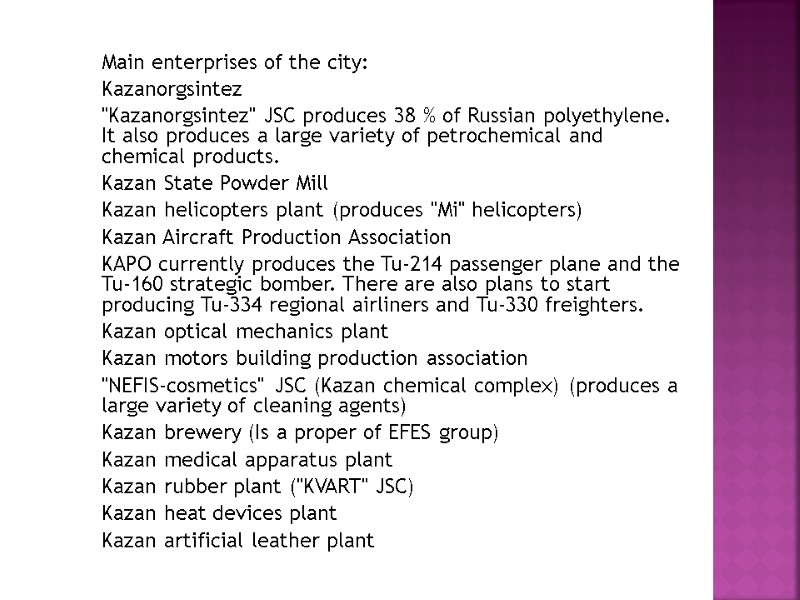
Main enterprises of the city: Kazanorgsintez "Kazanorgsintez" JSC produces 38 % of Russian polyethylene. It also produces a large variety of petrochemical and chemical products. Kazan State Powder Mill Kazan helicopters plant (produces "Mi" helicopters) Kazan Aircraft Production Association KAPO currently produces the Tu-214 passenger plane and the Tu-160 strategic bomber. There are also plans to start producing Tu-334 regional airliners and Tu-330 freighters. Kazan optical mechanics plant Kazan motors building production association "NEFIS-cosmetics" JSC (Kazan chemical complex) (produces a large variety of cleaning agents) Kazan brewery (Is a proper of EFES group) Kazan medical apparatus plant Kazan rubber plant ("KVART" JSC) Kazan heat devices plant Kazan artificial leather plant
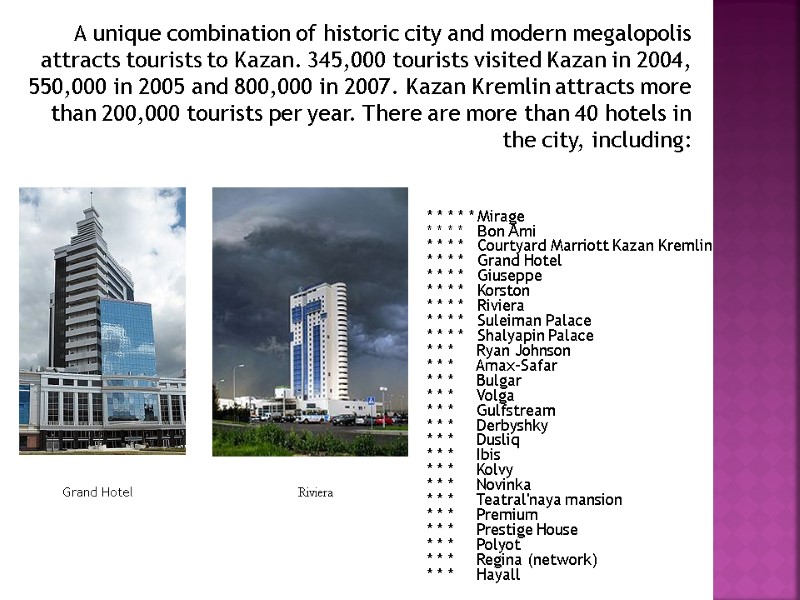
A unique combination of historic city and modern megalopolis attracts tourists to Kazan. 345,000 tourists visited Kazan in 2004, 550,000 in 2005 and 800,000 in 2007. Kazan Kremlin attracts more than 200,000 tourists per year. There are more than 40 hotels in the city, including: Grand Hotel Riviera * * * * * Mirage * * * * Bon Ami * * * * Courtyard Marriott Kazan Kremlin * * * * Grand Hotel * * * * Giuseppe * * * * Korston * * * * Riviera * * * * Suleiman Palace * * * * Shalyapin Palace * * * Ryan Johnson * * * Amax-Safar * * * Bulgar * * * Volga * * * Gulfstream * * * Derbyshky * * * Dusliq * * * Ibis * * * Kolvy * * * Novinka * * * Teatral'naya mansion * * * Premium * * * Prestige House * * * Polyot * * * Regina (network) * * * Hayall
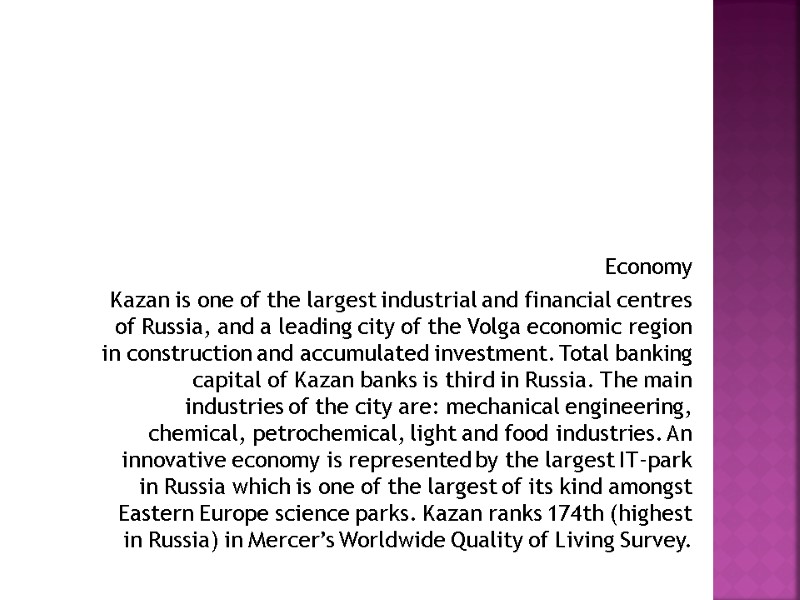
Economy Kazan is one of the largest industrial and financial centres of Russia, and a leading city of the Volga economic region in construction and accumulated investment. Total banking capital of Kazan banks is third in Russia. The main industries of the city are: mechanical engineering, chemical, petrochemical, light and food industries. An innovative economy is represented by the largest IT-park in Russia which is one of the largest of its kind amongst Eastern Europe science parks. Kazan ranks 174th (highest in Russia) in Mercer’s Worldwide Quality of Living Survey.
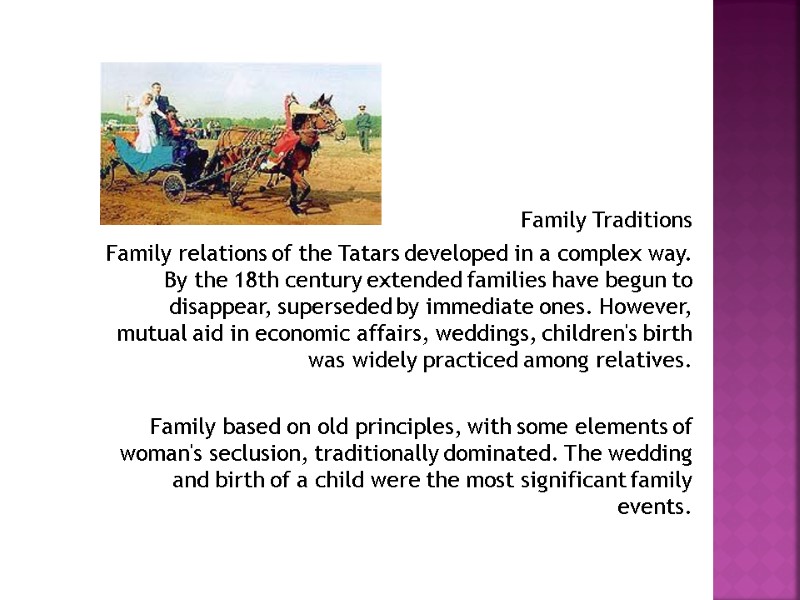
Family Traditions Family relations of the Tatars developed in a complex way. By the 18th century extended families have begun to disappear, superseded by immediate ones. However, mutual aid in economic affairs, weddings, children's birth was widely practiced among relatives. Family based on old principles, with some elements of woman's seclusion, traditionally dominated. The wedding and birth of a child were the most significant family events.
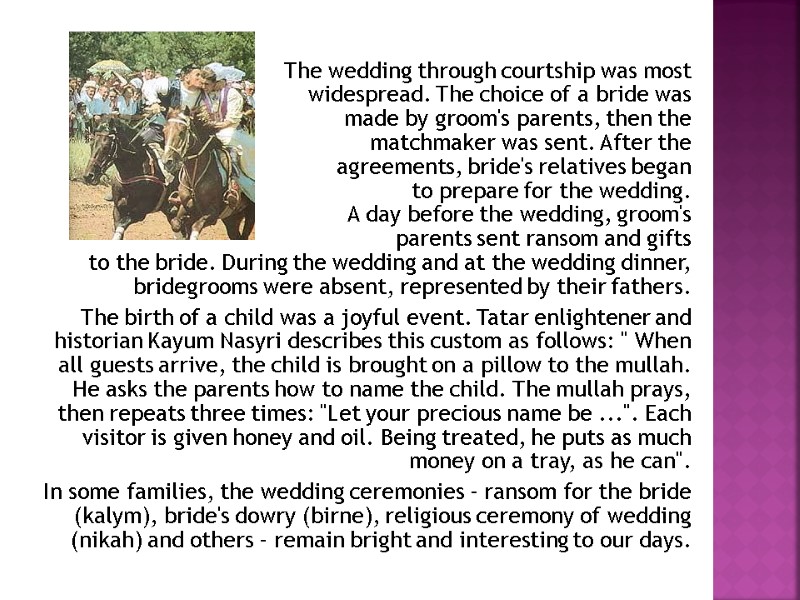
The wedding through courtship was most widespread. The choice of a bride was made by groom's parents, then the matchmaker was sent. After the agreements, bride's relatives began to prepare for the wedding. A day before the wedding, groom's parents sent ransom and gifts to the bride. During the wedding and at the wedding dinner, bridegrooms were absent, represented by their fathers. The birth of a child was a joyful event. Tatar enlightener and historian Kayum Nasyri describes this custom as follows: " When all guests arrive, the child is brought on a pillow to the mullah. He asks the parents how to name the child. The mullah prays, then repeats three times: "Let your precious name be ...". Each visitor is given honey and oil. Being treated, he puts as much money on a tray, as he can". In some families, the wedding ceremonies - ransom for the bride (kalym), bride's dowry (birne), religious ceremony of wedding (nikah) and others - remain bright and interesting to our days.
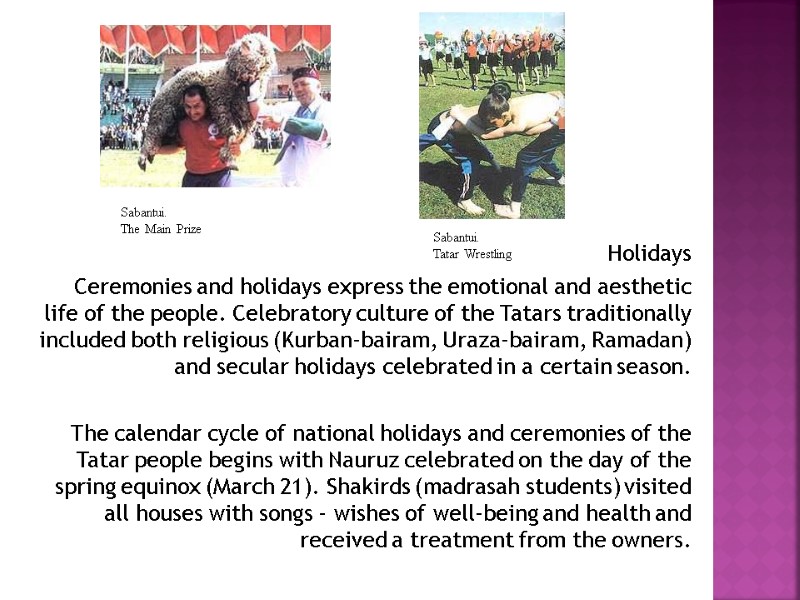
Holidays Ceremonies and holidays express the emotional and aesthetic life of the people. Celebratory culture of the Tatars traditionally included both religious (Kurban-bairam, Uraza-bairam, Ramadan) and secular holidays celebrated in a certain season. The calendar cycle of national holidays and ceremonies of the Tatar people begins with Nauruz celebrated on the day of the spring equinox (March 21). Shakirds (madrasah students) visited all houses with songs - wishes of well-being and health and received a treatment from the owners. Sabantui. The Main Prize Sabantui. Tatar Wrestling
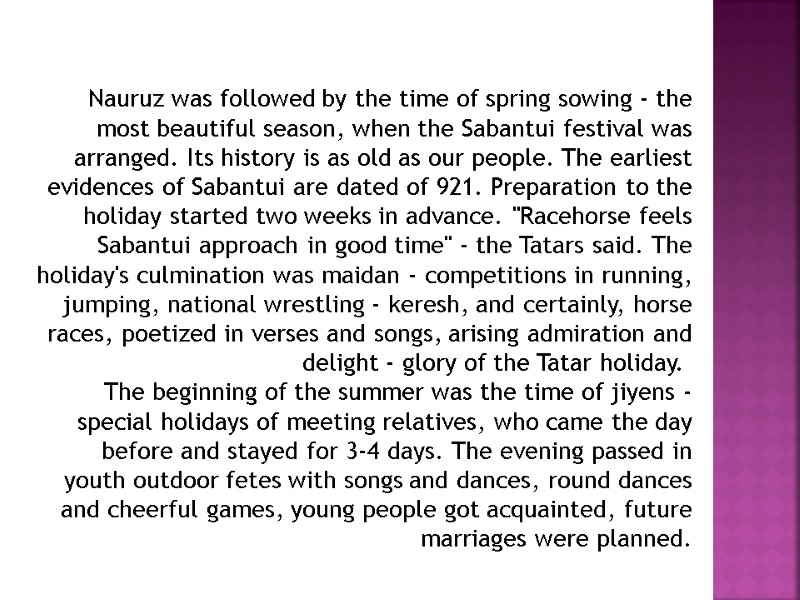
Nauruz was followed by the time of spring sowing - the most beautiful season, when the Sabantui festival was arranged. Its history is as old as our people. The earliest evidences of Sabantui are dated of 921. Preparation to the holiday started two weeks in advance. "Racehorse feels Sabantui approach in good time" - the Tatars said. The holiday's culmination was maidan - competitions in running, jumping, national wrestling - keresh, and certainly, horse races, poetized in verses and songs, arising admiration and delight - glory of the Tatar holiday. The beginning of the summer was the time of jiyens - special holidays of meeting relatives, who came the day before and stayed for 3-4 days. The evening passed in youth outdoor fetes with songs and dances, round dances and cheerful games, young people got acquainted, future marriages were planned.
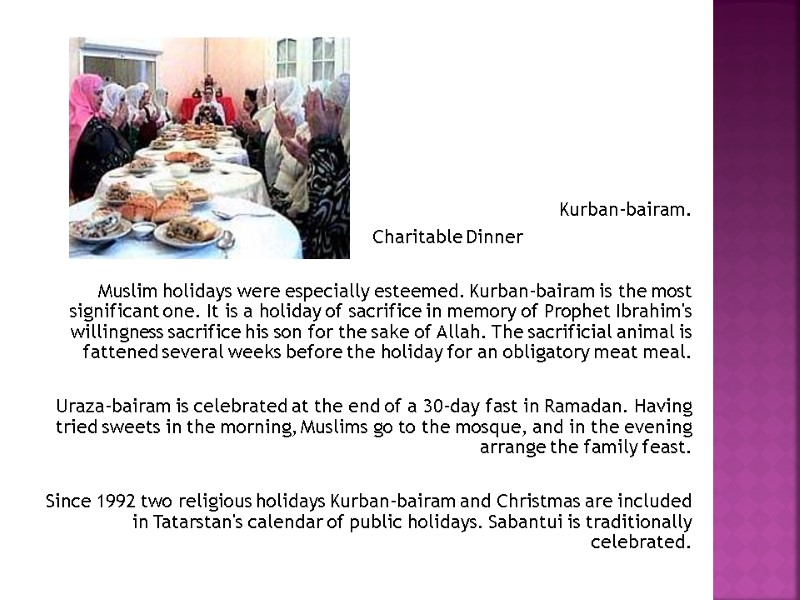
Kurban-bairam. Charitable Dinner Muslim holidays were especially esteemed. Kurban-bairam is the most significant one. It is a holiday of sacrifice in memory of Prophet Ibrahim's willingness sacrifice his son for the sake of Allah. The sacrificial animal is fattened several weeks before the holiday for an obligatory meat meal. Uraza-bairam is celebrated at the end of a 30-day fast in Ramadan. Having tried sweets in the morning, Muslims go to the mosque, and in the evening arrange the family feast. Since 1992 two religious holidays Kurban-bairam and Christmas are included in Tatarstan's calendar of public holidays. Sabantui is traditionally celebrated.
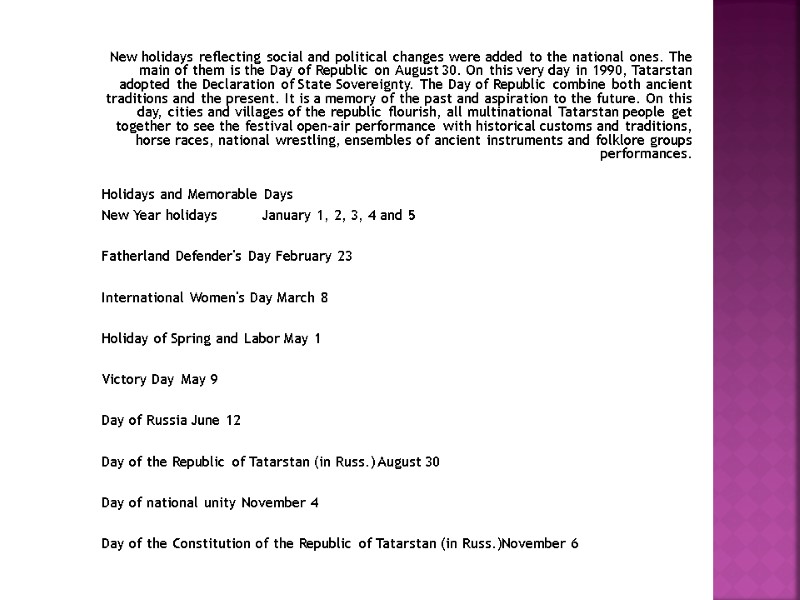
New holidays reflecting social and political changes were added to the national ones. The main of them is the Day of Republic on August 30. On this very day in 1990, Tatarstan adopted the Declaration of State Sovereignty. The Day of Republic combine both ancient traditions and the present. It is a memory of the past and aspiration to the future. On this day, cities and villages of the republic flourish, all multinational Tatarstan people get together to see the festival open-air performance with historical customs and traditions, horse races, national wrestling, ensembles of ancient instruments and folklore groups performances. Holidays and Memorable Days New Year holidays January 1, 2, 3, 4 and 5 Fatherland Defender's Day February 23 International Women's Day March 8 Holiday of Spring and Labor May 1 Victory Day May 9 Day of Russia June 12 Day of the Republic of Tatarstan (in Russ.) August 30 Day of national unity November 4 Day of the Constitution of the Republic of Tatarstan (in Russ.) November 6
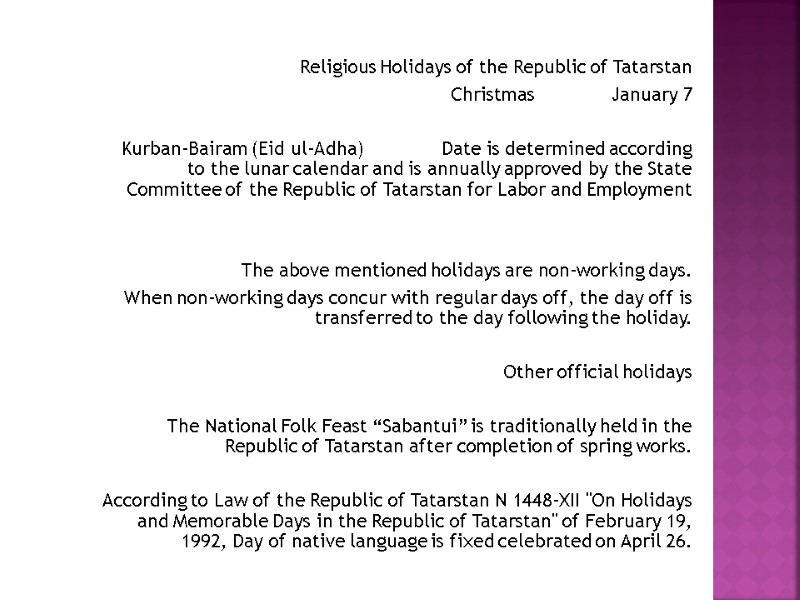
Religious Holidays of the Republic of Tatarstan Christmas January 7 Kurban-Bairam (Eid ul-Adha) Date is determined according to the lunar calendar and is annually approved by the State Committee of the Republic of Tatarstan for Labor and Employment The above mentioned holidays are non-working days. When non-working days concur with regular days off, the day off is transferred to the day following the holiday. Other official holidays The National Folk Feast “Sabantui” is traditionally held in the Republic of Tatarstan after completion of spring works. According to Law of the Republic of Tatarstan N 1448-XII "On Holidays and Memorable Days in the Republic of Tatarstan" of February 19, 1992, Day of native language is fixed celebrated on April 26.
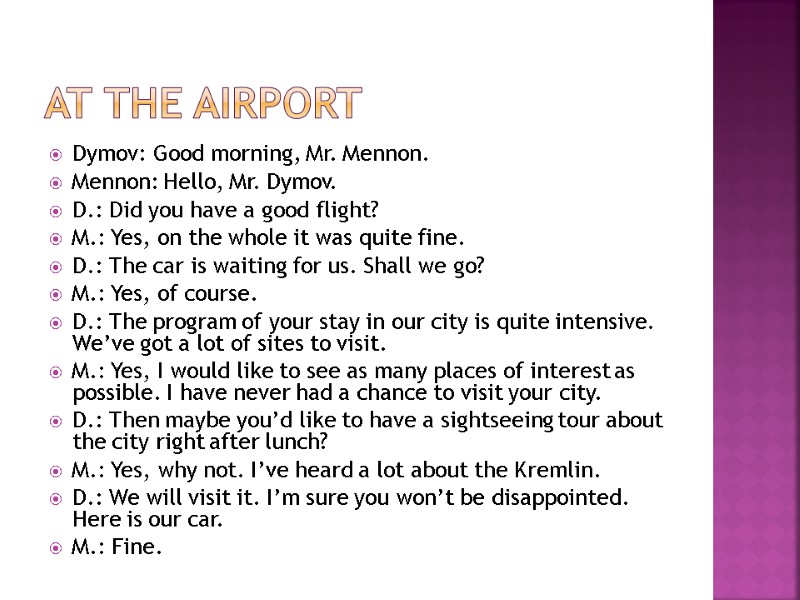
At the airport Dymov: Good morning, Mr. Mennon. Mennon: Hello, Mr. Dymov. D.: Did you have a good flight? M.: Yes, on the whole it was quite fine. D.: The car is waiting for us. Shall we go? M.: Yes, of course. D.: The program of your stay in our city is quite intensive. We’ve got a lot of sites to visit. M.: Yes, I would like to see as many places of interest as possible. I have never had a chance to visit your city. D.: Then maybe you’d like to have a sightseeing tour about the city right after lunch? M.: Yes, why not. I’ve heard a lot about the Kremlin. D.: We will visit it. I’m sure you won’t be disappointed. Here is our car. M.: Fine.
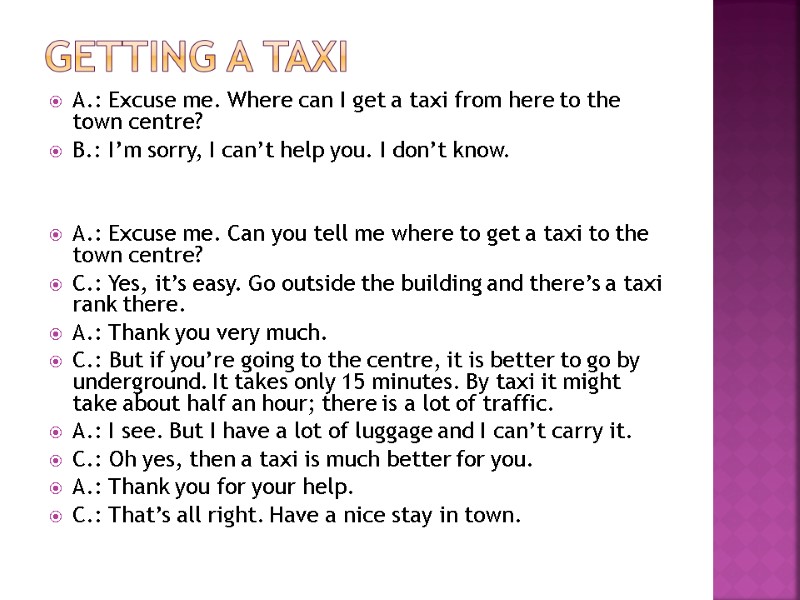
Getting a taxi A.: Excuse me. Where can I get a taxi from here to the town centre? B.: I’m sorry, I can’t help you. I don’t know. A.: Excuse me. Can you tell me where to get a taxi to the town centre? C.: Yes, it’s easy. Go outside the building and there’s a taxi rank there. A.: Thank you very much. C.: But if you’re going to the centre, it is better to go by underground. It takes only 15 minutes. By taxi it might take about half an hour; there is a lot of traffic. A.: I see. But I have a lot of luggage and I can’t carry it. C.: Oh yes, then a taxi is much better for you. A.: Thank you for your help. C.: That’s all right. Have a nice stay in town.
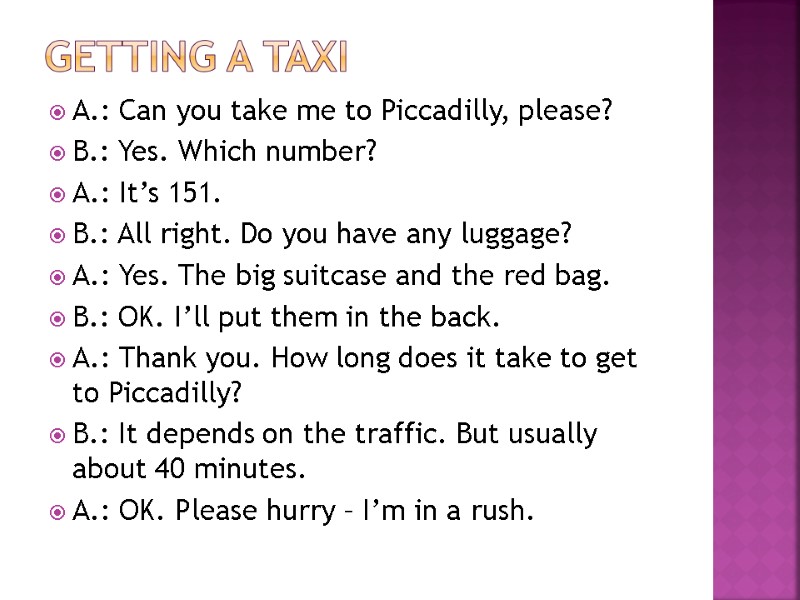
Getting a taxi A.: Can you take me to Piccadilly, please? B.: Yes. Which number? A.: It’s 151. B.: All right. Do you have any luggage? A.: Yes. The big suitcase and the red bag. B.: OK. I’ll put them in the back. A.: Thank you. How long does it take to get to Piccadilly? B.: It depends on the traffic. But usually about 40 minutes. A.: OK. Please hurry – I’m in a rush.

Getting a taxi A.: Yes, madam? B.: Can you take me to the Regent Hotel? A.: Yes. But which Regent Hotel? There are two Regent Hotels in this town. B.: Oh really? This one is in the High Street. A.: OK, no problem. Do you have any luggage? B.: Yes, this suitcase. A.: Fine, I’ll put it in the back. B.: Thank you. How long does it take to get to the town centre? I’m in a rush. A.: Don’t worry, madam, we’ll be there in about 30 minutes. B.: OK.
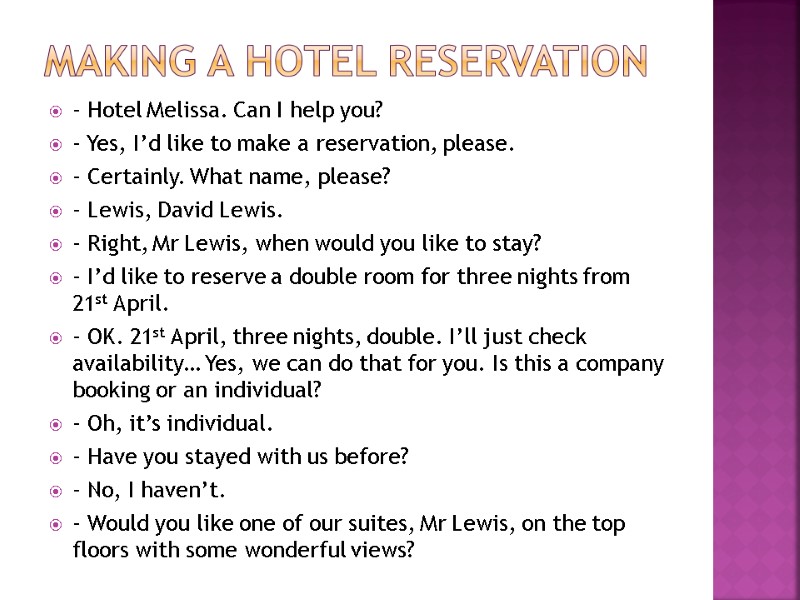
Making a hotel reservation - Hotel Melissa. Can I help you? - Yes, I’d like to make a reservation, please. - Certainly. What name, please? - Lewis, David Lewis. - Right, Mr Lewis, when would you like to stay? - I’d like to reserve a double room for three nights from 21st April. - OK. 21st April, three nights, double. I’ll just check availability… Yes, we can do that for you. Is this a company booking or an individual? - Oh, it’s individual. - Have you stayed with us before? - No, I haven’t. - Would you like one of our suites, Mr Lewis, on the top floors with some wonderful views?

- Well, actually, no, I wouldn’t. My wife doesn’t like using lift and also she’s got a bad leg, so I was hoping we could have a room near the ground floor. - OK. I’ll make a note of that and when you check in the receptionist will allocate a room on the first floor for you. - Thank you. - Will you be paying by credit card? - Yes, I will. It’s visa. - And what is the number, please? - Hold on… It’s 433517136094. - So that’s 433517136094. And your address? - 14 St John’s Road, London NW6. - OK, Mr Lewis, that’s reserved for you. Your reservation number is PS 1462. We look forward to seeing you on the 21st. - Thank you. - You’re welcome.
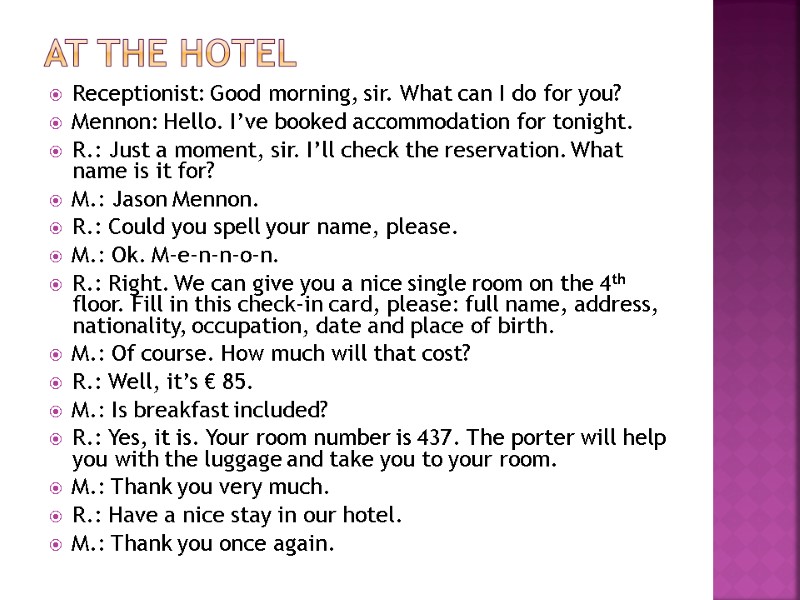
At the hotel Receptionist: Good morning, sir. What can I do for you? Mennon: Hello. I’ve booked accommodation for tonight. R.: Just a moment, sir. I’ll check the reservation. What name is it for? M.: Jason Mennon. R.: Could you spell your name, please. M.: Ok. M-e-n-n-o-n. R.: Right. We can give you a nice single room on the 4th floor. Fill in this check-in card, please: full name, address, nationality, occupation, date and place of birth. M.: Of course. How much will that cost? R.: Well, it’s € 85. M.: Is breakfast included? R.: Yes, it is. Your room number is 437. The porter will help you with the luggage and take you to your room. M.: Thank you very much. R.: Have a nice stay in our hotel. M.: Thank you once again.
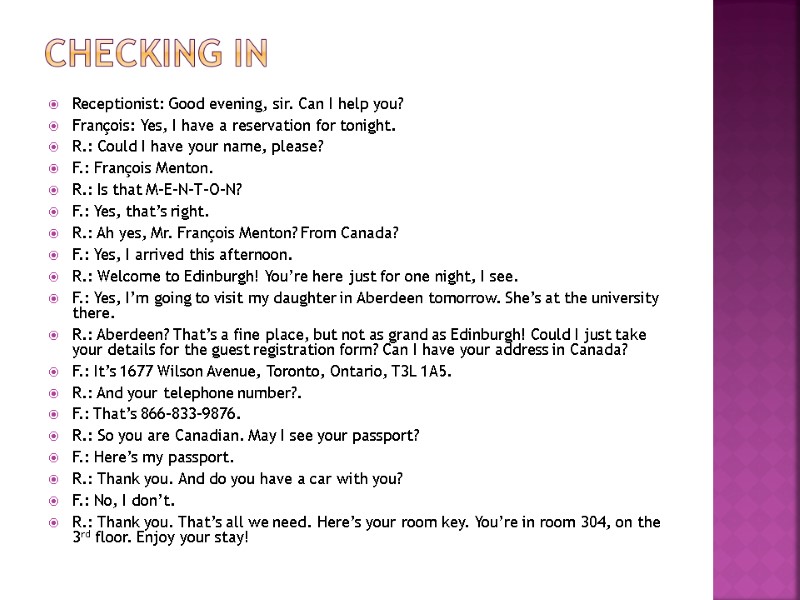
Checking in Receptionist: Good evening, sir. Can I help you? François: Yes, I have a reservation for tonight. R.: Could I have your name, please? F.: François Menton. R.: Is that M-E-N-T-O-N? F.: Yes, that’s right. R.: Ah yes, Mr. François Menton? From Canada? F.: Yes, I arrived this afternoon. R.: Welcome to Edinburgh! You’re here just for one night, I see. F.: Yes, I’m going to visit my daughter in Aberdeen tomorrow. She’s at the university there. R.: Aberdeen? That’s a fine place, but not as grand as Edinburgh! Could I just take your details for the guest registration form? Can I have your address in Canada? F.: It’s 1677 Wilson Avenue, Toronto, Ontario, T3L 1A5. R.: And your telephone number?. F.: That’s 866-833-9876. R.: So you are Canadian. May I see your passport? F.: Here’s my passport. R.: Thank you. And do you have a car with you? F.: No, I don’t. R.: Thank you. That’s all we need. Here’s your room key. You’re in room 304, on the 3rd floor. Enjoy your stay!

Ответьте на вопросы: 1. How long is François staying for? 2. When did he arrive? 3. Why is he going to Aberdeen? 4. What does the receptionist ask to see? 5. Does François have a car? 6. What floor is his room on? 7. Where does François come from?
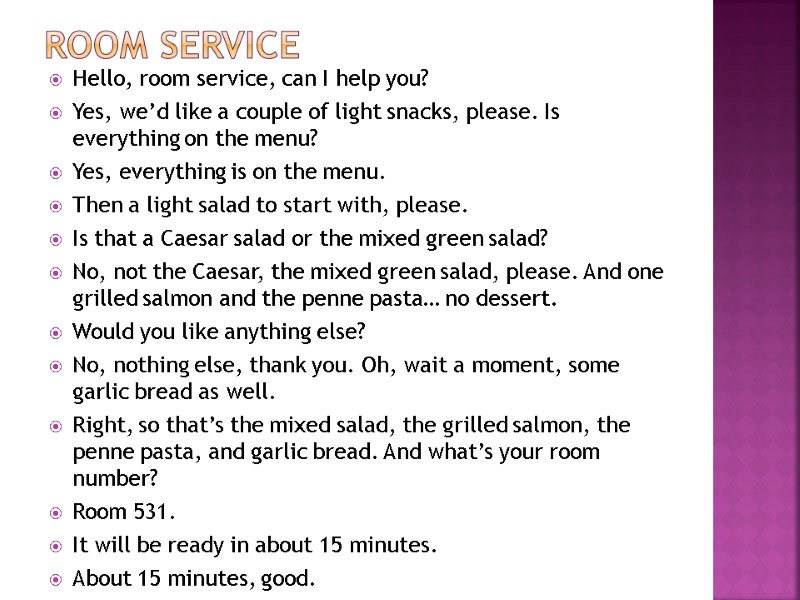
room service Hello, room service, can I help you? Yes, we’d like a couple of light snacks, please. Is everything on the menu? Yes, everything is on the menu. Then a light salad to start with, please. Is that a Caesar salad or the mixed green salad? No, not the Caesar, the mixed green salad, please. And one grilled salmon and the penne pasta… no dessert. Would you like anything else? No, nothing else, thank you. Oh, wait a moment, some garlic bread as well. Right, so that’s the mixed salad, the grilled salmon, the penne pasta, and garlic bread. And what’s your room number? Room 531. It will be ready in about 15 minutes. About 15 minutes, good.
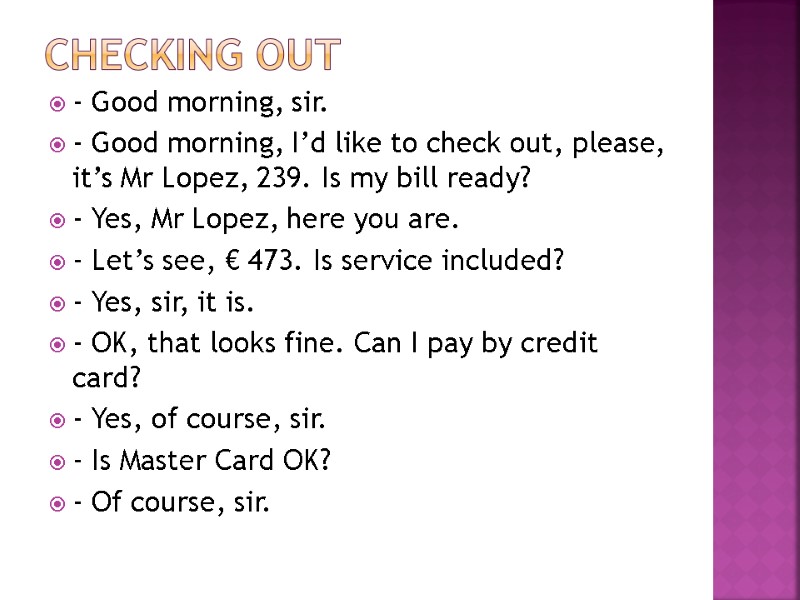
checking out - Good morning, sir. - Good morning, I’d like to check out, please, it’s Mr Lopez, 239. Is my bill ready? - Yes, Mr Lopez, here you are. - Let’s see, € 473. Is service included? - Yes, sir, it is. - OK, that looks fine. Can I pay by credit card? - Yes, of course, sir. - Is Master Card OK? - Of course, sir.
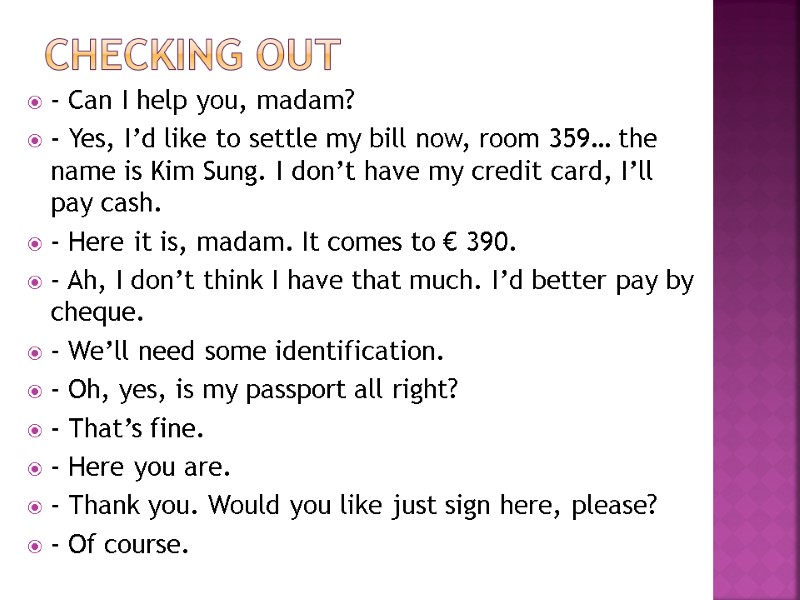
checking out - Can I help you, madam? - Yes, I’d like to settle my bill now, room 359… the name is Kim Sung. I don’t have my credit card, I’ll pay cash. - Here it is, madam. It comes to € 390. - Ah, I don’t think I have that much. I’d better pay by cheque. - We’ll need some identification. - Oh, yes, is my passport all right? - That’s fine. - Here you are. - Thank you. Would you like just sign here, please? - Of course.
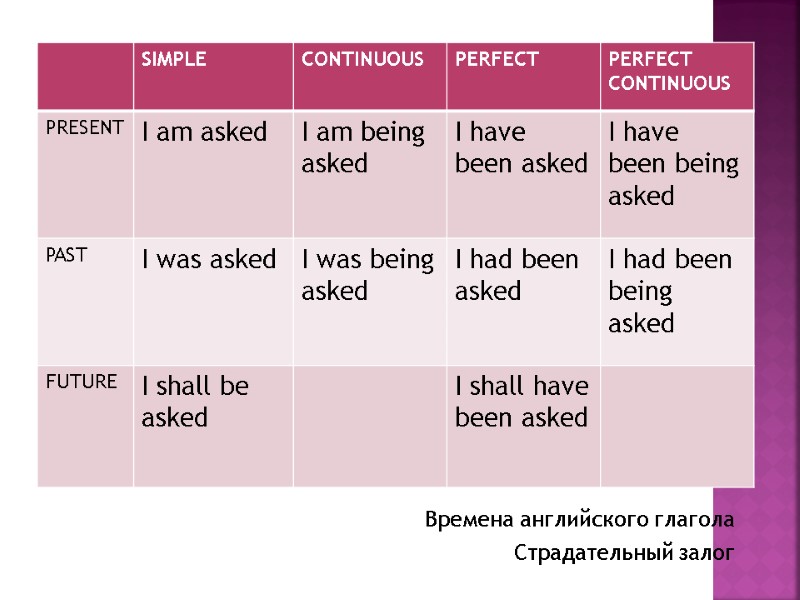
Времена английского глагола Страдательный залог
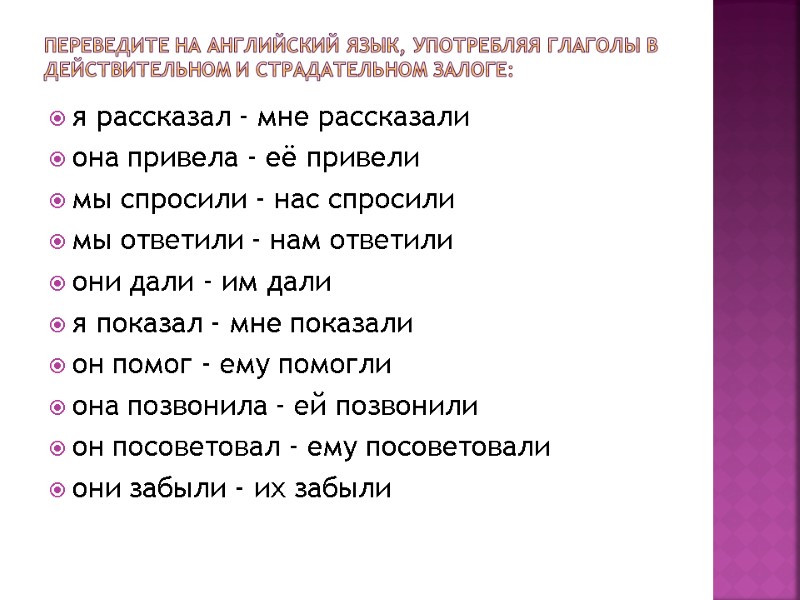
Переведите на английский язык, употребляя глаголы в действительном и страдательном залоге: я рассказал - мне рассказали она привела - её привели мы спросили - нас спросили мы ответили - нам ответили они дали - им дали я показал - мне показали он помог - ему помогли она позвонила - ей позвонили он посоветовал - ему посоветовали они забыли - их забыли
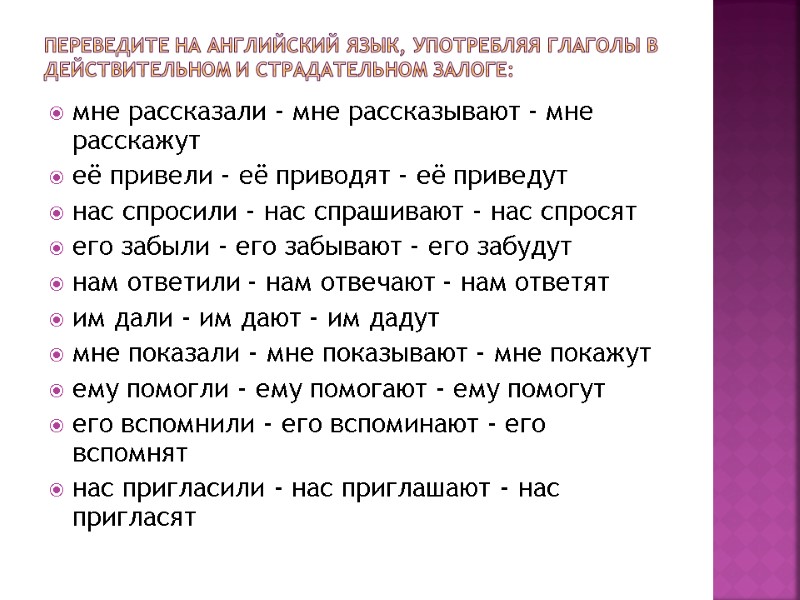
Переведите на английский язык, употребляя глаголы в действительном и страдательном залоге: мне рассказали - мне рассказывают - мне расскажут её привели - её приводят - её приведут нас спросили - нас спрашивают - нас спросят его забыли - его забывают - его забудут нам ответили - нам отвечают - нам ответят им дали - им дают - им дадут мне показали - мне показывают - мне покажут ему помогли - ему помогают - ему помогут его вспомнили - его вспоминают - его вспомнят нас пригласили - нас приглашают - нас пригласят
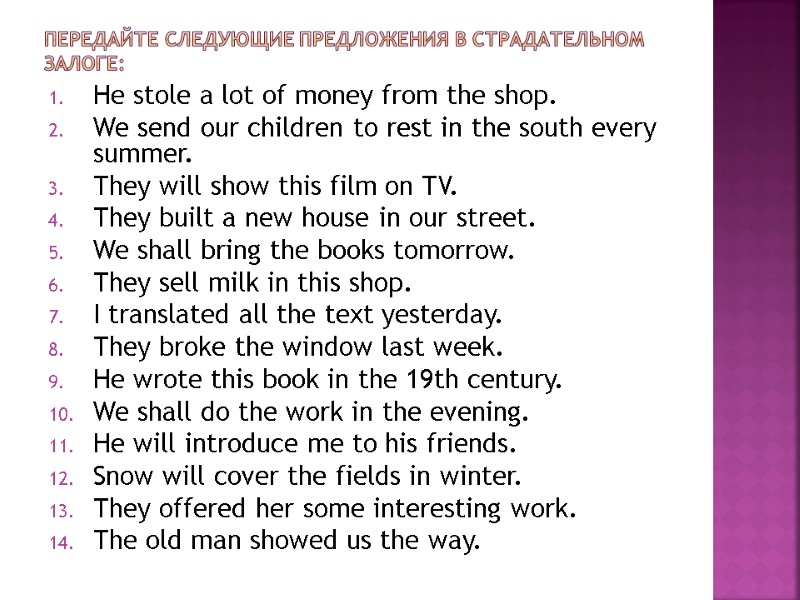
Передайте следующие предложения в страдательном залоге: He stole a lot of money from the shop. We send our children to rest in the south every summer. They will show this film on TV. They built a new house in our street. We shall bring the books tomorrow. They sell milk in this shop. I translated all the text yesterday. They broke the window last week. He wrote this book in the 19th century. We shall do the work in the evening. He will introduce me to his friends. Snow will cover the fields in winter. They offered her some interesting work. The old man showed us the way.
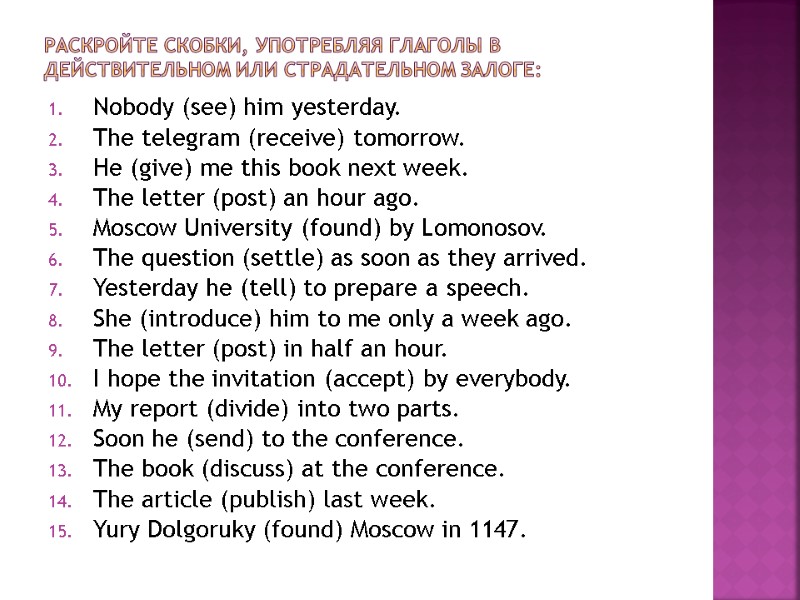
Раскройте скобки, употребляя глаголы в действительном или страдательном залоге: Nobody (see) him yesterday. The telegram (receive) tomorrow. He (give) me this book next week. The letter (post) an hour ago. Moscow University (found) by Lomonosov. The question (settle) as soon as they arrived. Yesterday he (tell) to prepare a speech. She (introduce) him to me only a week ago. The letter (post) in half an hour. I hope the invitation (accept) by everybody. My report (divide) into two parts. Soon he (send) to the conference. The book (discuss) at the conference. The article (publish) last week. Yury Dolgoruky (found) Moscow in 1147.

COMPLEX OBJECT
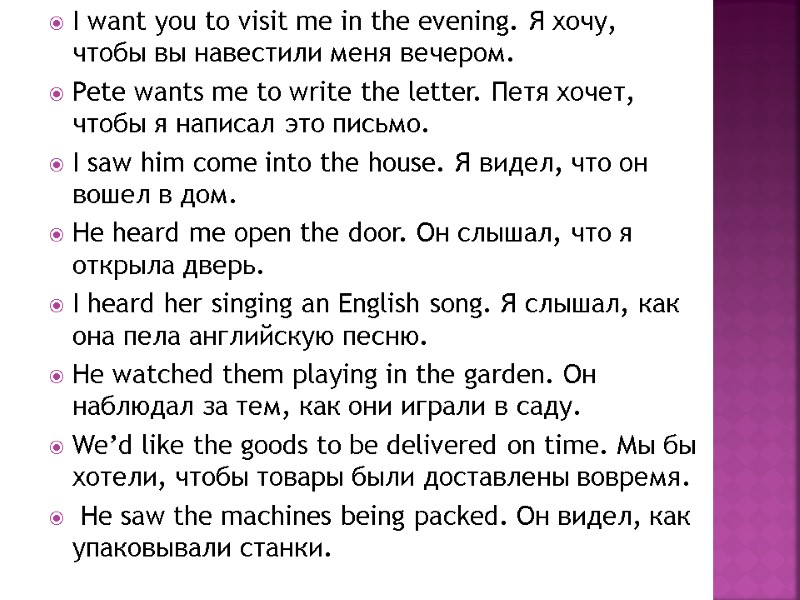
I want you to visit me in the evening. Я хочу, чтобы вы навестили меня вечером. Pete wants me to write the letter. Петя хочет, чтобы я написал это письмо. I saw him come into the house. Я видел, что он вошел в дом. He heard me open the door. Он слышал, что я открыла дверь. I heard her singing an English song. Я слышал, как она пела английскую песню. He watched them playing in the garden. Он наблюдал за тем, как они играли в саду. We’d like the goods to be delivered on time. Мы бы хотели, чтобы товары были доставлены вовремя. He saw the machines being packed. Он видел, как упаковывали станки.
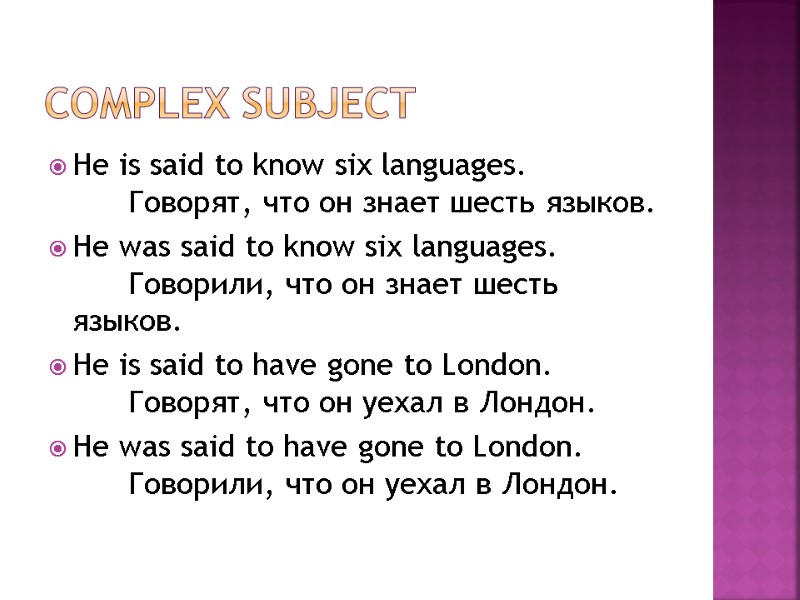
Complex subject He is said to know six languages. Говорят, что он знает шесть языков. He was said to know six languages. Говорили, что он знает шесть языков. He is said to have gone to London. Говорят, что он уехал в Лондон. He was said to have gone to London. Говорили, что он уехал в Лондон.
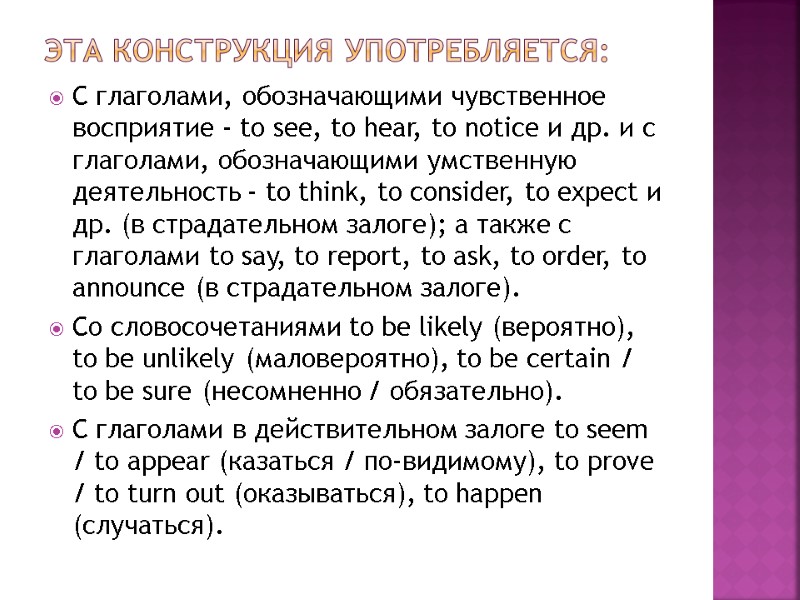
Эта конструкция употребляется: С глаголами, обозначающими чувственное восприятие - to see, to hear, to notice и др. и с глаголами, обозначающими умственную деятельность - to think, to consider, to expect и др. (в страдательном залоге); а также с глаголами to say, to report, to ask, to order, to announce (в страдательном залоге). Со словосочетаниями to be likely (вероятно), to be unlikely (маловероятно), to be certain / to be sure (несомненно / обязательно). С глаголами в действительном залоге to seem / to appear (казаться / по-видимому), to prove / to turn out (оказываться), to happen (случаться).
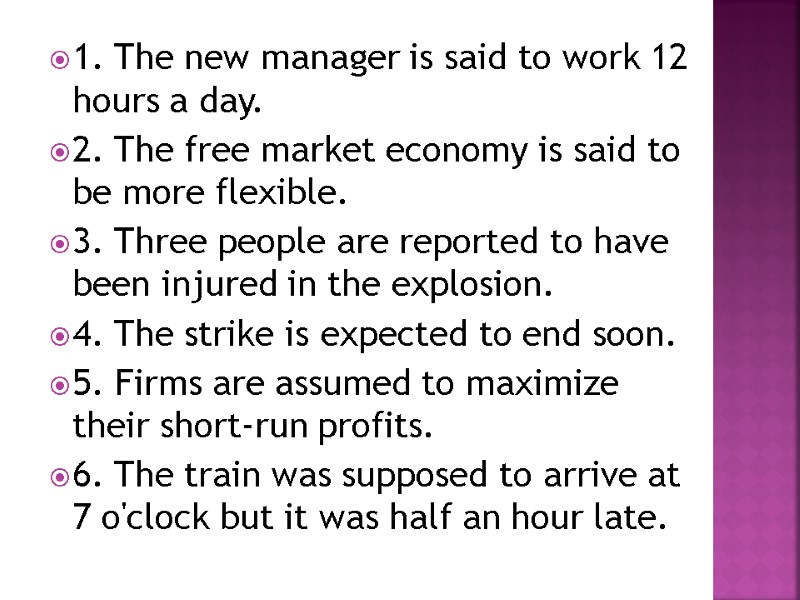
1. The new manager is said to work 12 hours a day. 2. The free market economy is said to be more flexible. 3. Three people are reported to have been injured in the explosion. 4. The strike is expected to end soon. 5. Firms are assumed to maximize their short-run profits. 6. The train was supposed to arrive at 7 o'clock but it was half an hour late.
15874-unit_2_tatarstan1.ppt
- Количество слайдов: 56

